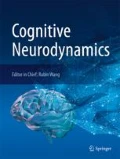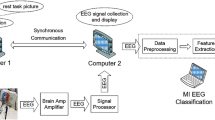Abstract
Brain-computer interface (BCI) system based on motor imagery (MI) usually adopts multichannel Electroencephalograph (EEG) signal recording method. However, EEG signals recorded in multi-channel mode usually contain many redundant and artifact information. Therefore, selecting a few effective channels from whole channels may be a means to improve the performance of MI-based BCI systems. We proposed a channel evaluation parameter called position priori weight-permutation entropy (PPWPE), which include amplitude information and position information of a channel. According to the order of PPWPE values, we initially selected half of the channels with large PPWPE value from all sampling electrode channels. Then, the binary gravitational search algorithm (BGSA) was used in searching a channel combination that will be used in determining an optimal channel combination. The features were extracted by common spatial pattern (CSP) method from the final selected channels, and the classifier was trained by support vector machine. The PPWPE + BGSA + CSP channel selection method is validated on two data sets. Results showed that the PPWPE + BGSA + CSP method obtained better mean classification accuracy (88.0% vs. 57.5% for Data set 1 and 91.1% vs. 79.4% for Data set 2) than All-C + CSP method. The PPWPE + BGSA + CSP method can achieve higher classification in fewer channels selected. This method has great potential to improve the performance of MI-based BCI systems.










Similar content being viewed by others
References
Acharya UR, Fujita H, Sudarshan VK, Bhat S, Koh JEW (2015) Application of entropies for automated diagnosis of epilepsy using EEG signals: a review. Knowl Based Syst 88:85–96
Alcaide-Aguirre RE, Huggins JE (2014) Novel hold-release functionality in a P300 brain–computer interface. J Neural Eng 11:066010
Alotaiby T, Abd El-Samie FE, Alshebeili SA, Ahmad I (2015) A review of channel selection algorithms for EEG signal processing. EURASIP J Adv Signal Process 201:66
Ang KK et al (2011) A large clinical study on the ability of stroke patients to use an EEG-based motor imagery brain–computer interface. Clin EEG Neurosci 42:253–258
Aydemir O, Ergun E (2019) A robust and subject-specific sequential forward search method for effective channel selection in brain computer interfaces. J Neurosci Methods 313:60–67
Bandt C, Pompe B (2002) Permutation entropy: a natural complexity measure for time series. Phys Rev Lett 88:174102
Blankertz B, Dornhege G, Krauledat M, Muller KR, Curio G (2007) The non-invasive Berlin brain–computer interface: fast acquisition of effective performance in untrained subjects. Neuroimage 37:539–550
Chang CC, Lin CJ (2011) LIBSVM: a Library for Support Vector Machines. ACM Trans Intell Syst Technol 2:1–27
Cheng MM, Lu ZH, Wang HX (2017) Regularized common spatial patterns with subject-to-subject transfer of EEG signals. Cogn Neurodyn 11:173–181
Deng B, Cai LH, Li SN, Wang RF, Yu HT, Chen Y, Wang J (2017) Multivariate multi-scale weighted permutation entropy analysis of EEG complexity for Alzheimer’s disease. Cogn Neurodyn 11:217–231
Dokare I, Kant N (2014) Classification of EEG signal for imagined left and right hand movement for brain computer interface applications. Int J Appl Innov Eng Manag 2014:291–294
Dong EZ, Li CH, Li LT, Du SZ, Belkacem AN, Chen C (2017) Classification of multi-class motor imagery with a novel hierarchical SVM algorithm for brain-computer interfaces. Med Biol Eng Comput 55:1809–1818
Dornhege G, Blankertz B, Curio G, Muller K-R (2004) Boosting bit rates in noninvasive EEG single-trial classifications by feature combination and multiclass paradigms. IEEE Trans Biomed Eng 51:993–1002
Fadlallah B, Chen BD, Keil A, Principe J (2013) Weighted-permutation entropy: a complexity measure for time series incorporating amplitude information. Phys Rev E 87:022911
Feng JK et al (2018) Towards correlation-based time window selection method for motor imagery BCIs. Neural Netw 102:87–95
Gaume A, Dreyfus G, Vialatte FB (2019) A cognitive brain-computer interface monitoring sustained attentional variations during a continuous task. Cogn Neurodyn 13:257–269
Ghaemi A, Rashedi E, Pourrahimi AM, Kamandar M, Rahdari F (2017) Automatic channel selection in EEG signals for classification of left or right hand movement in Brain Computer Interfaces using improved binary gravitation search algorithm. Biomed Signal Process Control 33:109–118
Hazarika J (2019) Wavelet transform based approach for EEG feature selection of motor imagery data for brain computer interfaces. In: 3rd International conference on inventive systems and control (ICISC 2019)
He L, Hu Y, Li Y, Li D (2013) Channel selection by Rayleigh coefficient maximization based genetic algorithm for classifying single-trial motor imagery EEG. Neurocomputing 121:423–433
Jin J, Allison BZ, Sellers EW, Brunner C, Horki P, Wang XY, Neuper C (2011) An adaptive P300-based control system. J Neural Eng 8:036006
Jin J, Miao YY, Daly I, Zuo CL, Hu DW, Cichocki A (2019) Correlation-based channel selection and regularized feature optimization for MI-based BCI. Neural Netw 118:262–270
Jing-Ru S, Jian-Guo W, Zhong-Tao X, Yuan Y, Junjiang L (2019) A method for EEG contributory channel selection based on deep belief network. In: 2019 IEEE 8th data driven control and learning systems conference (DDCLS) proceedings, pp 1247–1252
Kee C-Y, Ponnambalam SC, Loo C-K (2015) Multi-objective genetic algorithm as channel selection method for P300 and motor imagery data set. Neurocomputing 161:120–131
Kevric J, Subasi A (2017) Comparison of signal decomposition methods in classification of EEG signals for motor-imagery BCI system. Biomed Signal Process Control 31:398–406
Kumar S, Sharma A (2018) A new parameter tuning approach for enhanced motor imagery EEG signal classification. Med Biol Eng Comput 56:1861–1874
Kumar S, Sharma A, Tsunoda T (2017) An improved discriminative filter bank selection approach for motor imagery EEG signal classification using mutual information. BMC Bioinform 18:545
McFarland DJ, Wolpaw JR (2011) Brain–computer interfaces for communication and control. Commun ACM 54:60–66
Miao MM, Wang AM, Liu FX (2017) A spatial-frequency-temporal optimized feature sparse representation-based classification method for motor imagery EEG pattern recognition. Med Biol Eng Comput 55:1589–1603
Nicolaou N, Georgiou J (2012) Detection of epileptic electroencephalogram based on permutation entropy and support vector machines. Expert Syst Appl 39:202–209
Puanhvuan D, Khemmachotikun S, Wechakarn P, Wijarn B, Wongsawat Y (2017) Navigation-synchronized multimodal control wheelchair from brain to alternative assistive technologies for persons with severe disabilities. Cogn Neurodyn 11:117–134
Qiu ZY, Jin J, Lam HK, Zhang Y, Wang XY, Cichocki A (2016) Improved SFFS method for channel selection in motor imagery based BCI. Neurocomputing 207:519–527
Radman M, Chaibakhsh A, Nariman-zadeh N, Huiguang H (2019) Generalized sequential forward selection method for channel selection in EEG signals for classification of left or right hand movement in BCI. In: 2019 9th international conference on computer and knowledge engineering (ICCKE), pp 137–142
Raghu S, Sriraam N, Kumar GP (2017) Classification of epileptic seizures using wavelet packet log energy and norm entropies with recurrent Elman neural network classifier. Cogn Neurodyn 11:51–66
Ramoser H, Muller-Gerking J, Pfurtscheller G (2000) Optimal spatial filtering of single trial EEG during imagined hand movement. IEEE Trans Rehabil Eng 8:441–446
Rashedi E, Nezamabadi-pour H, Saryazdi S (2010) BGSA: binary gravitational search algorithm. Nat Comput 9:727–745
Selim S, Tantawi MM, Shedeed HA, Badr A (2018) A CSP\AM-BA-SVM approach for motor imagery BCI system. IEEE Access 6:49192–49208
Tam W-K, Ke Z, Tong K-Y (2011) Performance of common spatial pattern under a smaller set of EEG electrodes in brain-computer interface on chronic stroke patients: a multi-session dataset study. In: 2011 annual international conference of the IEEE engineering in medicine and biology society. IEEE, pp 6344–6347
Vapnik V, Vapnik V (1998) Statistical learning theory. Wiley, New York
Yang JH, Singh H, Hines EL, Schlaghecken F, Iliescu DD, Leeson MS, Stocks NG (2012) Channel selection and classification of electroencephalogram signals: an artificial neural network and genetic algorithm-based approach. Artif Intell Med 55:117–126
Zeng H, Yang C, Dai GJ, Qin FW, Zhang JH, Kong WZ (2018) EEG classification of driver mental states by deep learning. Cogn Neurodyn 12:597–606
Zhang Y, Wang Y, Jin J, Wang XY (2017) Sparse bayesian learning for obtaining sparsity of EEG frequency bands based feature vectors in motor imagery classification. Int J Neural Syst 27:1650032
Zhao QB, Rutkowski TM, Zhang LQ, Cichocki A (2010) Generalized optimal spatial filtering using a kernel approach with application to EEG classification. Cogn Neurodynamics 4:355–358
Zuo CL et al (2019) Novel hybrid brain-computer interface system based on motor imagery and P300. Cogn Neurodyn 14:253–265
Acknowledgements
This work was supported by the National Key Research and Development Program 2017YFB13003002. This work was also supported in part by the Grant National Natural Science Foundation of China, under Grant Nos. 61573142, 61773164 and 91420302, the programme of Introducing Talents of Discipline to Universities (the 111 Project) under Grant B17017, and the “ShuGuang” project supported by Shanghai Municipal Education Commission and Shanghai Education Development Foundation under Grant 19SG25.
Author information
Authors and Affiliations
Corresponding authors
Additional information
Publisher's Note
Springer Nature remains neutral with regard to jurisdictional claims in published maps and institutional affiliations.
Rights and permissions
About this article
Cite this article
Sun, H., Jin, J., Kong, W. et al. Novel channel selection method based on position priori weighted permutation entropy and binary gravity search algorithm. Cogn Neurodyn 15, 141–156 (2021). https://doi.org/10.1007/s11571-020-09608-3
Received:
Revised:
Accepted:
Published:
Issue Date:
DOI: https://doi.org/10.1007/s11571-020-09608-3




